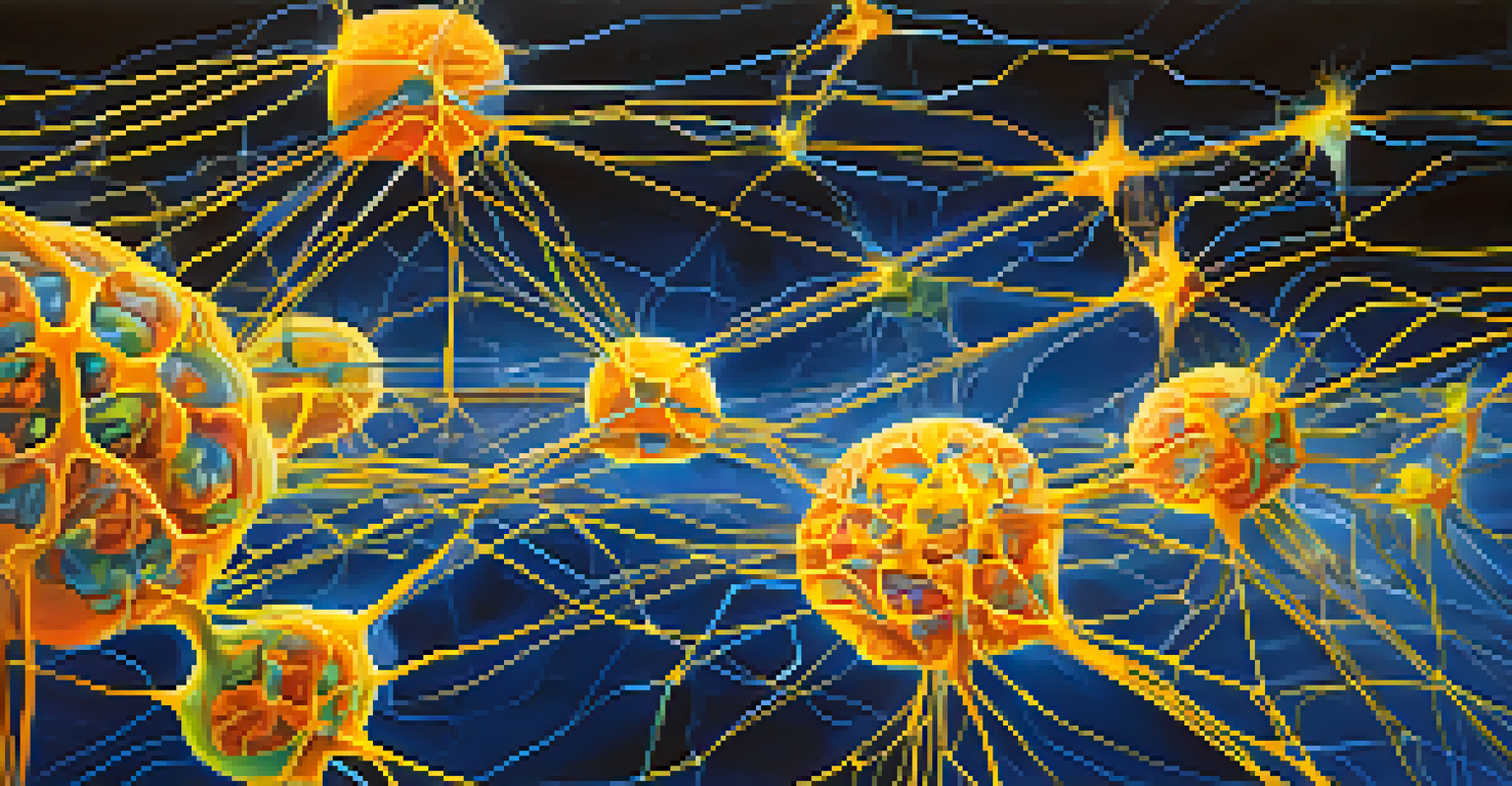Neurological Insights into Altered States Induced by Entheogens

Understanding Entheogens and Their Effects on the Brain
Entheogens are substances that induce altered states of consciousness, often used in spiritual or therapeutic contexts. These compounds, like psilocybin or ayahuasca, interact with serotonin receptors in the brain, which can lead to profound changes in perception and emotion. Understanding how these substances work neurologically can shed light on their potential benefits and risks, especially in therapeutic settings.
Psychedelics can help us to see our minds and our place in the universe more clearly.
When ingested, entheogens can lead to heightened sensory experiences and altered thought patterns. This is largely due to their influence on neurotransmitter systems, particularly serotonin, which plays a pivotal role in mood regulation and cognitive function. As researchers delve deeper, they are discovering just how these changes can affect our understanding of consciousness itself.
Moreover, the exploration of entheogens is not just about their mind-altering effects; it's about understanding the brain's plasticity. This plasticity allows the brain to adapt and reorganize itself, which can be particularly beneficial in treating mental health disorders. By studying the neurological impacts of entheogens, we can better appreciate their potential therapeutic applications.
The Role of Brain Networks in Altered States
Altered states induced by entheogens have a significant impact on various brain networks. For instance, the default mode network (DMN), which is active during self-referential thought, often shows decreased activity. This reduction can lead to a sense of ego dissolution, where individuals feel less connected to their personal identity and more connected to the universe around them.

Conversely, other brain networks, such as the salience network, may become hyperactive during these experiences. This network is responsible for detecting and filtering salient stimuli, which means that users may experience heightened awareness of their surroundings. This can result in vivid imagery and intense emotional responses, often described as spiritual or transformative.
Entheogens Alter Brain Function
Entheogens like psilocybin and ayahuasca significantly influence neurotransmitter systems, particularly serotonin, leading to altered perceptions and emotional experiences.
Understanding these network dynamics helps scientists map out how entheogens interact with our brains, providing key insights into the mechanisms behind these altered states. It also raises intriguing questions about how these experiences can foster creativity, enhance problem-solving abilities, and lead to lasting changes in perspective.
The Science of Neurotransmitters and Entheogens
Neurotransmitters are the brain's chemical messengers, and they play a vital role in how entheogens affect our thoughts and feelings. For example, psilocybin and other psychedelics primarily target serotonin receptors, particularly the 5-HT2A receptor. This interaction can lead to altered perception, mood changes, and even introspective insights that many users report.
The mind is not a vessel to be filled but a fire to be kindled.
Additionally, entheogens can also influence other neurotransmitter systems, such as dopamine and glutamate. This multi-faceted interaction can lead to a complex array of effects, ranging from enhanced emotional experiences to shifts in cognitive processing. By unraveling these interactions, researchers can better understand the potential therapeutic uses of these substances.
The ongoing research into neurotransmitter dynamics opens up exciting possibilities for treating mental health issues like depression and anxiety. By harnessing the power of entheogens, we might be able to create targeted therapies that not only alleviate symptoms but also promote long-lasting changes in mental health.
Neuroplasticity and the Impact of Entheogens
Neuroplasticity refers to the brain's ability to reorganize itself by forming new neural connections throughout life. Entheogens have been shown to promote neuroplasticity, which can be crucial for recovery from trauma or mental health disorders. This means that the experiences induced by these substances may not just be temporary; they could lead to lasting changes in how we think and feel.
Research suggests that entheogens can increase levels of brain-derived neurotrophic factor (BDNF), a protein that supports neuron growth and survival. Elevated BDNF levels can enhance learning and memory, making it a key player in the brain's adaptation process. This effect can be particularly beneficial for individuals dealing with depression, as it may help them develop new coping mechanisms and resilience.
Neuroplasticity Benefits Mental Health
The use of entheogens can promote neuroplasticity, potentially aiding recovery from mental health disorders by fostering new neural connections.
As our understanding of neuroplasticity grows, so does the potential for using entheogens in therapeutic settings. By fostering an environment where the brain can heal and adapt, these substances may offer a powerful tool for mental health professionals seeking to help their clients achieve transformative change.
Personal Experiences: The Subjective Nature of Altered States
While scientific research provides valuable insights, the subjective experiences of individuals who use entheogens are equally important. Many users report profound personal transformations, spiritual awakenings, or a heightened sense of connection to themselves and others. These experiences can vary greatly from person to person, influenced by factors such as mindset, environment, and dosage.
This subjectivity is what makes studying entheogenic experiences so complex yet fascinating. For instance, some individuals may encounter feelings of bliss and unity, while others might confront deep-seated fears or unresolved trauma. Understanding these diverse experiences can help researchers and therapists tailor approaches to maximize the positive effects of entheogens and minimize potential negative outcomes.
Moreover, the stories shared by users can serve as powerful testimonials that illustrate the profound impact these substances can have on one’s psyche. By listening to these narratives, we can better appreciate the nuances of altered states and the potential for personal growth they may offer.
Integrating Entheogens into Mental Health Treatment
As interest in entheogens grows, so does the conversation around their integration into mental health treatment. Many researchers advocate for a balanced approach that combines traditional therapies with entheogenic experiences. This integrative model could provide patients with deeper insights into their mental health challenges while offering new avenues for healing.
For example, in clinical settings, therapists might guide patients through entheogenic experiences as part of a broader therapeutic process. This could involve preparatory sessions, the experience itself, and follow-up integration therapy to help patients make sense of their journeys. The goal is to create a supportive environment that fosters healing and understanding.
Personal Experiences Shape Outcomes
Individual experiences with entheogens vary greatly, highlighting the importance of personal context in understanding their subjective effects on mental health.
However, it’s essential to approach this integration carefully, considering legal, ethical, and safety concerns. Establishing clear frameworks for use within therapy can ensure that entheogens are employed responsibly and effectively, ultimately benefiting individuals seeking alternative paths to mental wellness.
The Future of Research on Entheogens and the Brain
The future of research into entheogens and their neurological effects is promising and full of potential. As societal attitudes shift and more studies are conducted, we can expect a deeper understanding of how these substances work within our brains. This could lead to groundbreaking therapies for mental health disorders and a broader acceptance of their use in various contexts.
Additionally, advancements in neuroimaging technologies will allow researchers to visualize brain activity during entheogenic experiences more accurately. These insights can help demystify the complex interactions happening in the brain and provide clearer evidence of their therapeutic benefits. The more we learn, the better equipped we will be to harness the power of these substances.

Ultimately, the ongoing dialogue surrounding entheogens, their effects on the brain, and their potential applications in mental health will shape the future of both research and therapeutic practices. By continuing to explore these fascinating compounds, we open the door to new possibilities for understanding and enhancing the human experience.